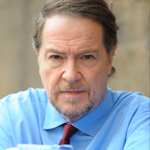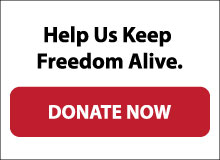John Whitehead's Commentary
Remember Auschwitz

It seemed to me, I'm in another world. It was so unbelievable that many of the prisoners had hallucinations.--Auschwitz SurvivorThe signs at the entrances merely said "BATHS." They were not sinister-looking places at all, especially with the well-kept lawns and flower borders. The music was sweet and light--even beautiful. One survivor recalled that an orchestra of "young and pretty girls all dressed in white blouses and navy-blue skirts" played the music.
The location? The gas chambers at the Nazi concentration camp at Auschwitz. William Shirer in The Rise and Fall of the Third Reich describes what happened to the unsuspecting Jews who thought they were simply being taken to the baths for delousing (which was customary at all concentration camps).
To music "recalling as it did happier and more frivolous times, the men, women and children were led into the 'bath houses,' where they were told to undress preparatory to taking a 'shower.' Sometimes they were given towels. Once they were inside the 'shower-room'--and perhaps this was the first moment that they may have suspected something was amiss, for as many as two thousand of them were packed into the chamber like sardines, making it difficult to take a bath--the massive door was slid shut, locked and hermetically sealed. Up above where the well-groomed lawn and flower beds almost concealed the mushroom-shaped lids of vents that ran up from the hall of death, orderlies stood ready to drop into them the amethyst-crystals of hydrogen cyanide....
"Surviving prisoners watching from blocks nearby remembered how for a time the signal for the orderlies to pour the crystals down the vents was given by a Sergeant Moll. 'Na, gib ihnen schon zu fressen' ('Alright, give 'em something to chew on'), he would laugh and the crystals would be poured through the openings, which were then sealed.
"Through heavy-glass portholes the executioners could watch what happened. The naked prisoners below would be looking up at the showers from which no water spouted or perhaps at the floor wondering why there were no drains. It took some moments for the gas to have much effect. But soon the inmates became aware that it was issuing from the perforations in the vents. It was then that they usually panicked, crowding away from the pipes and finally stampeding toward the huge metal door where...'they piled up in one blue clammy blood-spattered pyramid, clawing and mauling each other even in death.'"
The first people brought to Auschwitz and murdered were Polish political prisoners, followed by Soviet prisoners of war, Gypsies and deportees of various other nationalities. However, the most massive murder campaign in history began at Auschwitz in June 1942 when the Nazis put into operation a plan to systematically destroy the entire Jewish population of Europe. The camp was expanded to accommodate 30,000 prisoners, and an annex was built that held 100,000. As the trains stopped at the gates of Auschwitz, the Nazis began the selection process, when approximately 25% were determined "fit for work" and thus allowed to live a bit longer.
However, the great majority of Jews who were deported to Auschwitz--men, women and children--were immediately sent to their deaths in the gas chambers. When the Nazis realized that the end of the war was near, they attempted to remove all evidence of the atrocities committed there by dismantling the gas chambers, crematoriums and other buildings. They burned documents and evacuated all the prisoners who could walk to the interior of Germany. The total number of victims murdered at Auschwitz was approximately one million.
Auschwitz was liberated by the Russian army on January 27, 1945. Anatoly Shapiro was one of the first Russian officers to enter the infamous concentration camp. "When I saw the people," Shapiro, now 92, said recently in an interview (www.jta.org), "it was skin and bones. They had no shoes, and it was freezing. They couldn't even turn their heads, they stood like dead people."
When Shapiro entered one of the barracks, he was shocked beyond belief. "I saw blood, dead people, and in between them, women still alive and naked. It stank; you couldn't stay a second. No one took the dead to the grave. It was unbelievable."
Very few survivors or those who saw the horrors of Auschwitz are still alive. Yet those such as Shapiro are living witnesses of what can happen in a so-called civilized society. And make no mistake about it--it can happen again. That is why it is so vitally important that we fight every instance of such barbarity whenever and wherever it may arise. Otherwise, history will most likely repeat itself.
Martin Niemoeller understood the importance of standing against such crimes. A German pastor who was sentenced to a concentration camp for criticizing Hitler, Niemoeller is best known for his powerful statement about the failure of the German people to speak out against the Nazis:
"First they came for the Communists, but I was not a Communist so I did not speak out. Then they came for the Socialists and the Trade Unionists, but I was neither, so I did not speak out. Then they came for the Jews, but I was not a Jew so I did not speak out. And when they came for me, there was no one left to speak out for me."
ABOUT JOHN W. WHITEHEAD
Constitutional attorney and author John W. Whitehead is founder and president of The Rutherford Institute. His most recent books are the best-selling Battlefield America: The War on the American People, the award-winning A Government of Wolves: The Emerging American Police State, and a debut dystopian fiction novel, The Erik Blair Diaries. Whitehead can be contacted at staff@rutherford.org. Nisha Whitehead is the Executive Director of The Rutherford Institute. Information about The Rutherford Institute is available at www.rutherford.org.
Publication Guidelines / Reprint Permission
John W. Whitehead’s weekly commentaries are available for publication to newspapers and web publications at no charge. Please contact staff@rutherford.org to obtain reprint permission.



